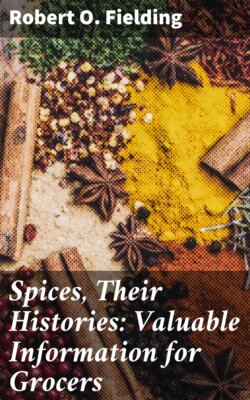Читать книгу Spices, Their Histories: Valuable Information for Grocers - Robert O. Fielding - Страница 4
На сайте Литреса книга снята с продажи.
ALLSPICE OR PIMENTO
A Valuable Product From Jamaica Which Combines the Flavor of Cloves, Cinnamon and Nutmeg
ОглавлениеTable of Contents
Allspice is the dried unripe berries of a tree of the myrtle family, the pimento, known botanically as Eugenia pimenta, or Pimenta officinalis. It’s an evergreen tree some 20 to 30 ft. high, with a slender, straight, upright trunk, much branched at the top; the bark is smooth, gray and aromatic; the leaves—which when fresh abound in essential oil—are 5 in. long, of an oblong shape and deep shiny green color; the blossoms—which appear in July and August—are white and fragrant; the berries (sometimes called corns), which form on the disappearance of the flower, are picked unripe, altho fully grown, they are of a greenish-purple color. After picking, the berries are dried in the sun or in kilns until dark brown and then separated from the stalk. The dried berries are light, brittle, of roundish form and crowned with the remains of the flower calyx in the shape of a raised, seared-like ring; each berry contains two dark-brown flattish, kidney-shaped seeds. If allowed to ripen, the berries lose their aromatic flavor and become merely sweet and pulpy. Only in Jamaica—where it is cultivated in plantations called Pimento walks—does the pimento tree grow to perfection, altho attempts are made to cultivate it in other West India islands and South America. It is thought to combine the flavor of cloves, cinnamon and nutmeg, hence it is called allspice.
Uses—Its chief use is for culinary purposes. It is a powerful irritant, good for dyspepsia, flatulency, gout, hysteria and toothache. It is often employed to disguise the nasty taste of medicine. Allspice yields volatile oil by distillation, which is used as a flavoring in alcoholic solution, is of a brownish-red, clear appearance, and has the odor and taste of pimento, but is warm and more pungent. A green fixed oil has the burning aromatic taste of pimento and is supposed to be the acrid principle. A tincture from allspice has been praised as an application in chilblains.
Substitutes.—The Mexican spice, called Pimento de Tabascol is somewhat larger and less aromatic than Jamaica pimento. The berries of Pimento acris, (bayberry) whose leaves are used in the manufacture of bay-rum. The Carolina allspice—calycanthus florides, a shrub 6 or 8 ft. high, with an odor somewhat like strawberries. Japan allspice—chimonanthus frangrans—which grows in Japan, and wild allspice—lindera benzoin—known also as spice-wood, fever-wood, benjamin-bush—a member of the laurel family growing in the United States. To secure uniformity of color these inferior kinds are often colored with Armenian bole, a kind of red clay from Armenia, and they are also often mixed in ground allspice, in addition to the stalks of the pimento. A kind of red pimento from Salonica is also used as an adulterant. During the civil war, when pimento was high in price, a substitute was made up of clove-stems, wasted rye, a little cayenne pepper, and some cassia; this was very acceptable, altho there was not an ounce of pimento in it.
